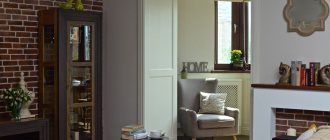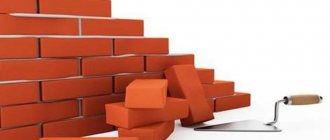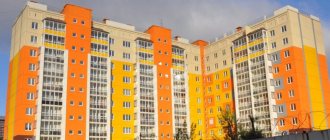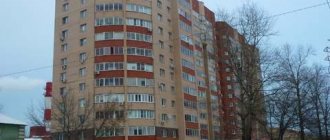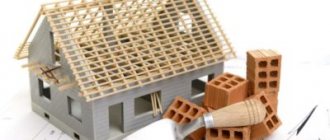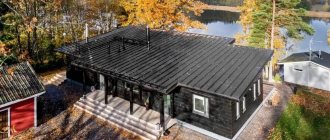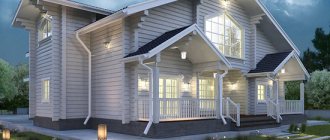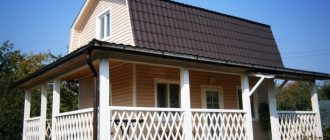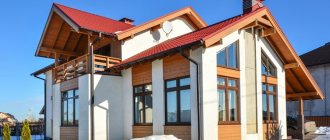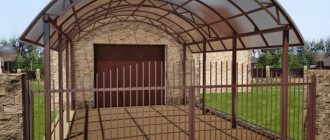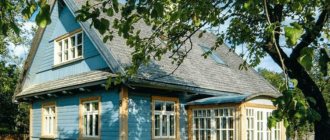Facade facing materials include various types of plaster, facade paints, panels, decorative tiles, stone, etc.
Facade slabs are used for cladding facades in order to protect walls from external influences and provide decorative design; if necessary, they resort to laying insulation between the wall and facade elements.
The range of facade curtain structures is large, so in order to make a choice, you should have information about the materials presented.
Why choose wall panels for exterior decoration of a house?
The development of the construction industry has given rise to the emergence of new modern materials for external cladding, characterized by excellent physical properties and reasonable prices. This is exactly what wall panels are, reducing the cost of building houses, extending its service life, and, at the same time, acting as a protective barrier from rain, snow, ultraviolet radiation, which negatively affects the surface of walls made from almost any building material.
Facade panels for exterior finishing of houses are widely used for treating the external surface of public buildings, private houses and cottages, shopping complexes, entertainment and sports centers, medical and educational institutions.
Wall panels have the following advantages:
- strength;
- frost resistance;
- soundproofing;
- long service life;
- a light weight;
- environmental friendliness;
- affordable price;
- variety of types, textures and colors.
- do not fade in the sun and do not lose color from rain;
- do not require special care or treatment;
- do not rot, are not attractive to insects and rodents;
House finished with facade slabs Source domcom.ru
Cladding panels for the facade of a house are suitable not only for new buildings, but also for finishing old buildings, regardless of the material of the building.
See also: Catalog of companies that specialize in facade and finishing materials.
Decorative slabs for exterior wall decoration are divided into several types, according to material and design:
- Sandwich panels. They consist of several layers of materials glued together. Each layer has different characteristics. The top one is a galvanized metal coating and has a protective function, and the bottom one acts as insulation.
- Composite panels. They are made on a cement base with a fiber filler or a thin layer of metal. This material protects walls well from external environmental influences that contribute to their destruction.
- Plates made of polyvinyl chloride and pressed wood pulp, externally made to look like wood, stone or brick.
Decorative panels for the external walls of a house, belonging to any of these categories, do not put pressure on the load-bearing walls of the building and the foundation.
Installing the entire house with facade slabs does not take much time. The work is completed within a period of two days to two weeks, depending on the area of the facade.
Decorating the wall of a house with facade slabs Source recon-stroi.ru
Materials with wood fibers
Quite inexpensive and high-quality building materials are a multi-layer structure made from wood fibers.
To protect them from moisture, they are coated with a layer of paint, while they are quite easy to process and install by installing an aluminum sheathing made of building profiles, which will provide additional thermal insulation.
Façade panel options
Panels for the facade of a house are classified according to several characteristics:
- in shape - rectangular, narrow elongated panels or a medium-sized module;
- according to texture - like stone, brick, wood, for painting;
- by the presence of thermal insulation - with or without insulation;
- according to the method of fastening - panels with a locking mechanism or those that do not require fixation with each other;
- by material - composite, polymers, metal, glass.
Metal
They can be made of aluminum or galvanized stainless steel with a polymer coating. They are not subject to corrosion, are not afraid of moisture, do not burn, and are easy to install. The main disadvantage is the lack of thermal insulation capabilities, as well as susceptibility to deformation.
Metal siding to look like wood Source 2gis.ru
Polymer
Polymer or PVC panels are the cheapest and most popular option for facade finishing.
They have a wide range of colors and are also available in versions that imitate natural materials. Plastic panels for home decoration are very light and easy to install, in addition, they have a long shelf life.
Design nuances
A weather- and mechanically resistant material that provides thermal insulation and protects the walls of the house from wear and tear is not all that is usually needed to enjoy looking at the house. Otherwise, everyone would live in houses covered with simple sandwich panels. Aesthetics are important.
Brick finish
It is affected by the location of the panels:
- Vertical. It will make the house visually taller, which is useful for small, squat houses.
- Horizontal. Will make the house appear lower and wider, which is useful for tall houses that look too narrow.
- Brick. It is used for base planks - they are not laid exactly on top of each other, but with an indentation, just like bricks are laid. It looks good and does not bring any special visual changes to the shape.
Vertical products will make the house visually taller
It is influenced by colors:
Bright white looks good, but it needs to be washed constantly, otherwise it will fade and turn gray very quickly. Bright black is usually not used for houses unless it is a Gothic style house.
The exception is a black background with a bright pattern or accessories that attract attention. But still, it is generally considered that the effect is too dark. Shades of yellow
The sunny color will attract attention to the house, making it visually cozier and more pleasant. A common color that looks good in a garden setting. Shades of green. They are rarely used for summer cottages, since a green house surrounded by greenery will look a little strange. But for a country cottage surrounded by other buildings, a garage and a neat garden, soft shades of mint or light green are well suited.
Bright white looks good but needs constant washing
- Shades of red. They are usually considered too bright and therefore undesirable, but muted options, such as brick, fully correspond to the classic ideas of a country house.
- Shades of brown. They look good and remind you of village houses. But it is not recommended to take cold or too dark ones.
- Delicate shades. Beige, pink, peach. They will make the house a little larger and more comfortable in appearance. Well suited for small houses where coziness is the main idea of the design.
- Cool shades. They will also make the house look larger, but at the same time more austere and darker. Pairs well with glass or metal inserts.
This is affected by the finish:
- Clean plastic. It does not look very aesthetically pleasing, because at one glance it seems that the house was cheap for the owners. But for a small house, which should not be too sophisticated, it is adequate.
- Pure wood or stone. Natural materials are always beautiful. The tree looks warm, cozy, reminiscent of villages and pleasant childhood memories. Stone is more austere, but if combined with wood, it will look softer.
- Pure metal. It goes well with glass, perfect for decorating a home in a high-tech style. Gives a special shine and severity of style. Reminds me of skyscrapers and industrial buildings.
- Clean glass. It goes well with metal, it really depends on the specific glass. Transparent looks extravagant, rich, a little strange. Matte is reminiscent of the sea, tall buildings, and the centers of large cities. It is good for frosted glass to be colored, this gives it additional charm.
Stylish country house
- Under the brick. It is made using PVC panels, the plastic for which is poured in several layers into a mold that replicates natural brickwork. From a distance it looks indistinguishable from real brick, is well suited for a house in a classic style, plus it allows you to save money - PVC is cheaper than real brick and much lighter.
- Under the tree. Made using fiber cement or PVC, it allows you to enjoy the aesthetic appearance, forgetting about all the shortcomings of wood and the fact that it needs to be renewed so that it does not rot. From a distance, again, it is indistinguishable, but up close it reveals nuances of color. The uniqueness of natural wood is missing.
- Under a stone. Natural stone is heavy and expensive, it is better to buy fiber cement or PVC for it. They, of course, wear out faster, but if you want to change the exterior of the house, replacing them will be much easier.
Horizontal products will make the house lower and wider in appearance
Tip It's a good idea to combine different materials. Lay stone-like panels in two rows, and finish the top with wood or wood-like panels. Include glass inserts between metal panels. The main thing is that the result is combined.
Cozy house in Provence style
Video description
In our video we will talk about Japanese facades. Let's take a closer look at what errors happen during the installation process:
Brick panels
Brick decoration of the external walls of a house has remained popular for many years; it gives the house an expensive look and a special zest. But at the same time, it requires certain costs; in addition to purchasing the material itself, it is necessary to purchase a solution and pay for the work of the master. But in the modern building materials market, an excellent, cheaper alternative to brick finishing has appeared - brick-look wall panels.
The characteristics of such panels are not inferior to natural brick, and in appearance they are almost no different from it. The structure can be homogeneous or combined (equipped with insulation).
Kinds
Plastic panels are divided into the following types:
- Under a stone . This type of plastic panels is represented by a variety of product options that can imitate various types of natural stone. The material can look like marble, brickwork, stonework and many other variations . The main advantage of using plastic panels for this type of cladding is that the cost of construction work will be several times less than if natural materials are used.
- Tree . This type of plastic panels is designed to imitate a variety of wood species . The assortment includes species from the simplest and most common tree species to rare and exclusive ones. The panels can also imitate different wood textures.
- Metal . In appearance, products of this type resemble galvanized steel or aluminum ; as for the surface, this material is available with both a smooth and perforated structure of the top layer.
Pros and cons of facing slabs
The advantages and disadvantages of different types of facade panels are presented in the table:
| Type of panels | pros | Minuses |
| Metal | low weight; affordable price; fire resistance; durability and strength. | the need to hire workers for installation; poor thermal insulation. |
| PVC | moisture resistance; frost resistance; ease of installation; resistance to environmental influences; environmental friendliness; low cost; wide range of colors; durability. | flammability; toxicity when burning; fragility. |
| Fiber cement | long service life; heat resistance; not subject to rotting and corrosion; | high moisture absorption (absorb up to 10% moisture from the air); subject to deformation; low impact resistance. |
| Clinker | moisture resistance; environmental friendliness; strength; low weight; variety of textures and colors. | surface preparation required before installation; high price; Vapor tightness (requires leaving space between the panel and the wall). |
| Sandwich panels | operation over 30 years; fire safety do not rot or rust; environmental friendliness; thermal insulation; strength; moisture resistance | require care during transportation and installation; freeze at temperatures from -200 C. |
| Glass | original design; good heat and sound insulation; absorption of UV rays. | low installation speed; high price. |
Technical specifications
Modern plastic products differ from the first releases in increased endurance and long service life. Cracks can only form if there is a significant deviation from operating standards. Plastic facade panels have the following technical characteristics:
- weight 1.5-2 kg/panel;
- the thickness of the products can be 0.7-1.2 mm;
- width 1300 and 1850 mm;
- length 2500-3800 mm;
- permissible tensile strength 100 MPa;
- thermal expansion 0.15%;
- thermal conductivity is 0.3 w/m*k;
- bending strength parameter 140 MPa;
- density 1.4 g/cc.
- resistance to temperature changes depends on the raw material, within -50℃.. +85℃.
There are no Russian regulations regarding the production of vinyl panels. There is an international standard developed by the American organization ASTM (American Society for Testing and Materials). Foreign and domestic companies are guided by these recommended optimal characteristics.
The thickness of panels whose service life exceeds 10 years, according to AST recommendations, should be 0.9-1.2 mm, and their tensile strength should be 422 kg/sq.cm. If plastic panels bear the ASTM mark, this means that the product is of high quality.
What to look for when choosing
The facade must have a long service life, be functional and resistant to many negative factors. That is why you should be responsible when choosing wall panels for the facade of a house.
When choosing a material, you should pay attention to the following aspects:
- There is a need for thermal insulation . If the walls of the building require additional insulation, it is optimal to choose panels with insulation. In this case, two problems will be solved with one material.
- Environmental conditions. For example, in case of high humidity, you should avoid those types that have a high level of moisture absorption, and for regions with a lot of sunny days, you should not choose panels that are likely to fade in the sun.
- Also, you should take into account the thickness of the walls of the building and its age .
Original house decorated with facade slabs Source prorab.guru
Polymer coated
These finishes are made from galvanized metal, which determines their high wear resistance and affordable cost.
The protective and decorative polymer layer is painted at the application stage, so such materials are offered in a fairly wide variety of colors, which helps decorate the building.
Installation features
Installation of panels for facade cladding requires preliminary preparation of the walls. The walls need to be cleaned of old finishes, dirt and dust, then treated with a layer of primer and a special compound.
Next, if necessary, the sheathing is installed. The facing frame is assembled from a thin metal profile or wooden slats. The frame needs to be treated with an anti-rust and rotting compound.
The lathing will provide additional thermal insulation; in addition, the walls will be ventilated, which will maintain a comfortable temperature in the room.
Then, the panels are attached to the supporting frame with nails, dowels or screws. In the absence of sheathing, the plates are simply glued to the wall with a special compound.
Clinker thermal panels
Insulation and facing layer form the basis of such panels. They are connected by special grooves around the perimeter. Mounting sleeves are provided for mounting to walls. Using polystyrene foam or polyurethane foam as insulation. Simple installation plus reliable fastening.
Such panels use grooves and tenons, which guarantee a monolithic installation. Over the course of a decade, they have deservedly come out ahead thanks to their long service life and excellent appearance. Clinker panels for facades reduce the costs used to heat houses by sixty percent.
